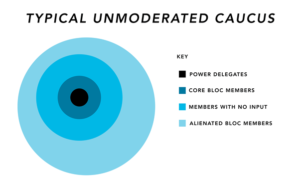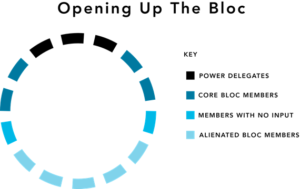By: Satya Amin (Media Associate)
If you’ve done Model U.N, you’ve encountered power delegates. They are often some of the toughest obstacles to run into. This piece, orchestrated by Satya Amin, draws from his personal experience of prevailing against power delegates, in a circuit notorious for having strong and assertive delegates.
We’ve all been there before— the Chair taps their gavel on the desk to signal an unmoderated caucus, and the room erupts in a chaotic frenzy of shouting delegates, each trying to squeeze their names on the sponsor’s list as soon as possible. Amidst this hullabaloo, at least one delegate will jump atop a table, scream louder than anyone else, and attempt to get the room to coalesce around them as they begin their lengthy explanation, or rather, dictation, of what is to be achieved over the coming few days.
The room by this point vaguely resembles two concentric circles— the inner one is occupied by the “power delegates”, a small cartel of individuals who, if left unchecked, are likely to simple steer the committee in their own predetermined direction, leaving little room for the guys on the outside. Often, a bloc dominated by “power delegates” in a large General Assembly may end up looking something like this:

Again, this is merely an illustration of how a bloc may end up. The actual situation depends on other factors, like the size of the room, for example.
The dictatorial style of bloc leadership practiced by these delegates has two primary consequences. For one, delegates are unable to contribute effectively to the discussion, resulting in ideas which could defeat a competing resolution being missed. The second important issue is that alienation from the bloc erodes support, as many of the quieter delegates simply slip off to join a bloc they perceive as more open to their contributions. Therefore, it’s fairly clear that as a delegate, it is imperative to develop a strategy to counter the most aggressive members of the bloc in order to ensure both the success of your country and your bloc in general. The question is, how?
Be Assertive
There’s a very fine line that exists between assertiveness and open aggression. Treading that boundary carefully earns respect; not just from the Executive Board, but also from the delegates in your bloc.
This approach centers primarily on countering aggression with your own, more diplomatic, brand of the same. Act as an advocate for the more timid delegates in the room by working as a counterpoint to the aggressive ones. Raise your voice when they raise theirs, but always be respectful and try to be the facilitator of democracy within the group. Even simple gestures, like asking a quieter delegate if they have a point to contribute, can go a long way in rallying support for your position amongst the members of the bloc.
“Let’s open up the circle”
Blocs sometimes tend to operate in concentric circles, as shown in the graphic above. This is problematic, as it leaves a majority of delegates isolated from the main discussions within the bloc.
Calling for the bloc to “spread out” a little is a fairly simple, but highly effective tactic to bring more people into the bloc’s discussions. Moving people away from the densely concentrated ‘center’ of the bloc helps to improve participation and prevent formerly alienated delegates from deserting the bloc.
This approach is also generally more effective than the “pass the pen” tactic often used here in India. In this approach, a pen, or another miscellaneous writing instrument, is passed around the bloc. The delegate holding the pen is the person entitled to speak. While this is a good idea in theory, the model breaks down very quickly in practice, as disagreements and impatience take precedence over respecting the rule of the pen.

Start Your Own Bloc
General Assembly votes are not decided by the small number of power delegates who run the blocs. Votes are decided by the large number of soft-spoken delegates in the room, some of whom may not speak for the entire duration of the conference. Winning over this demographic is key for any bloc to succeed. If the hardline aggressors in your bloc are proving too difficult to handle, forming another bloc may be an option worth exploring. The chances are that disillusioned members of other blocs will be willing to join, or at least sign on as signatories. At the very least, you can use your new bloc as leverage to secure a stronger position after a merger. While banking on a merger to gain a leadership position in the bloc is an admittedly risky play, it does offer interesting opportunities as well.
In conclusion, it is difficult to find a definite strategy to counter aggression. Overcoming dominant delegates in order to put your view across is arguably one of the hardest parts of Model United Nations, but it is nevertheless an important part of the learning experience that is Model UN. Keeping that in mind, stay positive in your approach and avoid feeling discouraged if your efforts do not yield a favourable result. If at first you don’t succeed, simply try another way.
Most importantly, always remember to help those who’s voices cannot be heard. Model UN is supposed to be a forum for discussion and debate. We all have a responsibility to make sure it stays that way.

